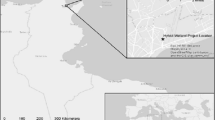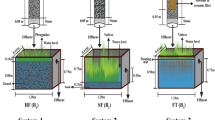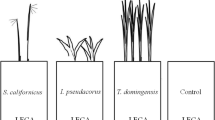Abstract
Tests were carried out under controlled conditions in the Experimental Plant of Viville (Arlon, Belgium) to enhance the purification of urban wastewater by “natural” means. The results demonstrate the need to structure treatment systems in a series of different artificial ecosystems (or a Hierarchical Mosaic of Artificial Ecosystems — MHEA in French). The first two levels we used were made up of an unplanted aquatic ecosystem (stabilization pond) followed by a semi-aquatic ecosystem planted withTypha latifolia L. in which the water flows over the substrate. At a flow rate of 4 m2/PE (1 PE=150 1/day of typical urban wastewaters in Belgian rural zones), this first stage substantially reduces suspended solids (SS), COD and BOD5, a significant amount of tot-N and tot-P, and reduces pathogens by 100-fold. Further, the system is easy to manage (sludge is eliminated in the first stage and biomass is collected in the second stage) and the treatment system does not clog up.
Nevertheless, real and sustainable environmental protection demands even higher performance rates, and these first two stages, both in terms of design and dimension, can only be considered as a satisfactory part of a MHEA system. Artificial aquatic, semi-aquatic, and terrestrial ecosystems were systematically compared at the third and fourth stage of the system to increase the overall removal efficiency.
The most complete and efficient system in our tests (i.e., the one that provides the most successful primary (SS), secondary (COD and BOD5) and tertiary (N and P) treatment and the best pathogens removal rates) was made up of 3 sequential series of ecosystems: an aquatic ecosystem whose flow went into a plantedTypha latifolia system (surface water flow), that flowed into a terrestrial ecosystem planted withAlnus glutinosa (L.) Gaertn (vertical subsurface water flow). A total surface area (stages 1–4) of 8 m2/PE ensured a high performance level whose outflow conformed to the strictest European norms.
Similar content being viewed by others
References
Bavor, H.J. and Andel, E.F. 1994. Nutrient removal and disinfection performance in the Byron Bay constructed wetland system. Wat. Sci. Tech. 29 (4): 201–208.
Chambers, J.M., Wrigley, T.J. and McComb A.J. 1993. The potential use of wetlands to reduce phosphorus export from agricultural catchments. Fertilizer Research 36: 157–164.
Hammer, D.A. and Knight R.L. 1994. Designing constructed wetlands for nitrogen removal. Wat. Sci. Tech. 29: 15–27.
Radoux, M. 1994. L'optimisation des technologies rustiques d'épuration: la Mosaïque Hiérarchisée d'Écosystèmes Artificiels.In: Dautrebande, S., Marcoen, J.M., Xanthoulis, D., Van Gysel, J. and Willam, C. (eds) Ateliers de l'Eau. pp 227–245. CEBEDOC, Liège.
Radoux, M., Cadelli, D. and Nemcova, M. 1995. L'optimisation des technologies extensives d'épuration des eaux usées sous climat tempéré (France) et sous climat sahélien (Sénégal). In: World-wide Symposium “Pollution in Large Cities” 1, pp 461–471. PadovaFiere Editrice, Padova.
Radoux, M. and Kemp, D. 1988. Épuration comparée des eaux usées domestiques par trois plantations hélophytiques et par un lagunage à microphytes sous un même climat tempéré. Acta Ęcologica, Ęcol. Applic. 9: 25–38.
Radoux, M. and Kemp, D. 1990. The impact of ageing on the purification efficiency of a plantation ofTypha latifolia L.In: Cooper, P.F. and Findlater, B.C. (eds), Constructed Wetlands in Water Pollution Control. pp. 149–159. Pergamon Press, Oxford.
Standard Methods for the Examination of Water and Wastewater. 18th edn. 1992, APHA, AWWA, WEF.
Author information
Authors and Affiliations
Rights and permissions
About this article
Cite this article
Radoux, M., Cadelli, D. & Nemcova, M. A comparison of purification efficiencies of various constructed ecosystems (aquatic, semi-aquatic and terrestrial) receiving urban wastewaters. Wetlands Ecol Manage 4, 207–217 (1996). https://doi.org/10.1007/BF01879239
Issue Date:
DOI: https://doi.org/10.1007/BF01879239




